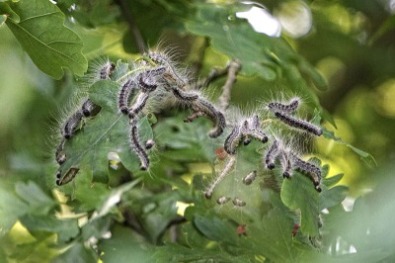...my rope gets in contact with the oak processionary moth?
One of the main questions in the rope world is “Is my rope/gear still good to work with?” Manufacturers specify a theoretical service life in their instructions for use. This is mainly based on very rare use. The actual service life, especially when the rope/gear is heavily used, depends on a lot of factors that are beyond the control of manufacturers. In this series, TEUFELBERGER presents the results of a study made on “Deliberate damage of ropes”. In this article, we answer some frequent questions about the topic “Washing above 60°C because of the oak processionary moth”.
The oak processionary moth is a tree pest whose caterpillars have stinging hairs that contain a nettle toxin that is also dangerous to humans. For this reason, arborists are increasingly being called out to combat these pests. Their equipment is also contaminated by these stinging hairs. The stinging nettle toxin contained in the hairs is a protein that can practically only be inactivated by heating to 60°C.
Therefore, the study tested the effect of washing above 60°C on the following TEUFELBERGER products:
- drenaLINE 11,8mm
- treeMOTION evo

1. Washing of ropes
For the tests, 2 samples of the drenaLINE of the same batch were tested. First, one of the samples was washed at 60°C for 45 min. without the addition of detergent. Then the washed and the unwashed rope were tested according to EN1891A.
No anomaly was detected!
The essential parameters measured according to EN 1891 A are still within the tolerance range even after washing and meet the standard requirements. In essence, the rope shrinks slightly in length as a result of washing at 60°C. And the diameter increases in return.
2. Washing of harnesses
On the treeMOTION evo, four harnesses of the same batch were tested. Two harnesses were washed at 60°C for 45 min. without the addition of detergents before testing. Subsequently, all four harnesses were tested statically and dynamically according to EN358/813.
No significant anomaly was found with the treeMOTION evo either! Only the breaking load of the washed harnesses was slightly reduced to an harmless extent.
In principle, the standard already includes a safety factor for wear. However, washing at 60°C should not be done too often!
Conclusion & Recommendations
- Ropes and Harnesses can be washed at 60°C to inactivate the oak processionary moth nettle toxin. No significant anomalies were found in the tests.
- The safety instructions in the manufacturer's information must be followed for all further rope and equipment care measures.
- Washing of ropes and equipment should still not be done too often. The long-term effects have not been tested yet.
- A detailed inspection of the rope/equipment is mandatory.
